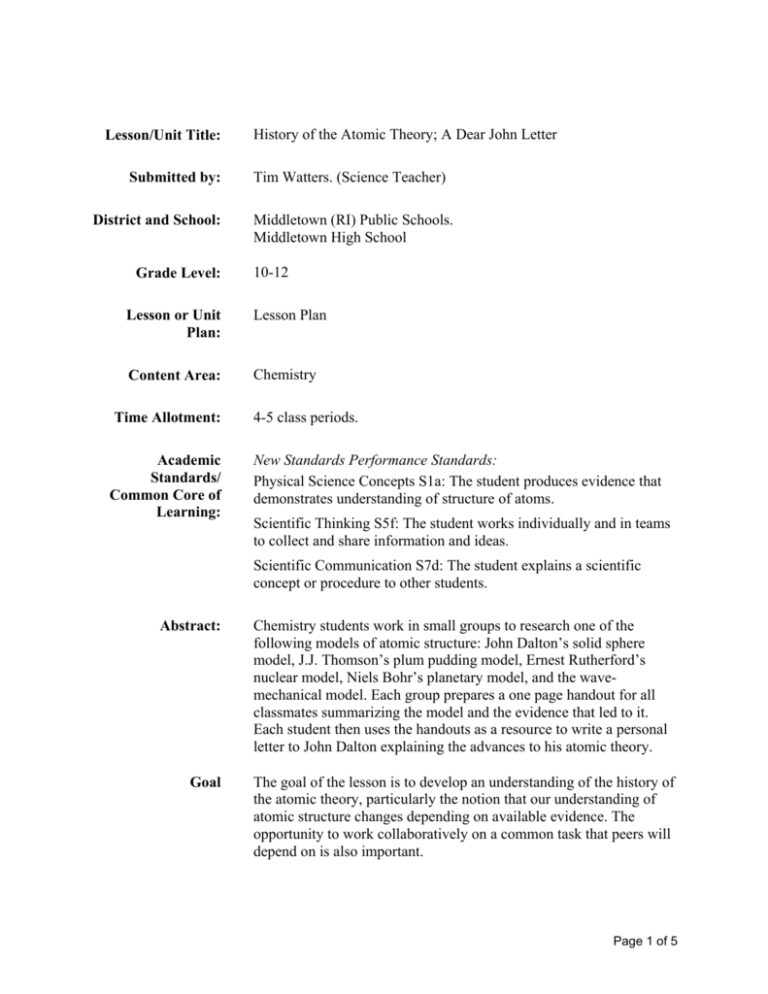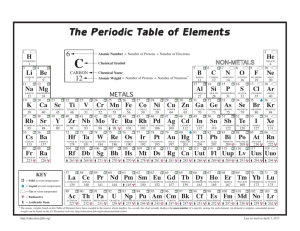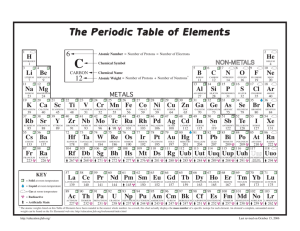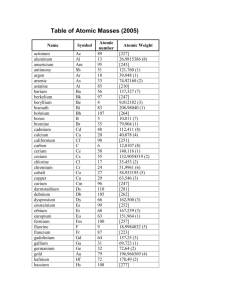History of the Atomic Theory: A Dear John Letter
advertisement

Lesson/Unit Title: Submitted by: District and School: Grade Level: History of the Atomic Theory; A Dear John Letter Tim Watters. (Science Teacher) Middletown (RI) Public Schools. Middletown High School 10-12 Lesson or Unit Plan: Lesson Plan Content Area: Chemistry Time Allotment: Academic Standards/ Common Core of Learning: 4-5 class periods. New Standards Performance Standards: Physical Science Concepts S1a: The student produces evidence that demonstrates understanding of structure of atoms. Scientific Thinking S5f: The student works individually and in teams to collect and share information and ideas. Scientific Communication S7d: The student explains a scientific concept or procedure to other students. Abstract: Goal Chemistry students work in small groups to research one of the following models of atomic structure: John Dalton’s solid sphere model, J.J. Thomson’s plum pudding model, Ernest Rutherford’s nuclear model, Niels Bohr’s planetary model, and the wavemechanical model. Each group prepares a one page handout for all classmates summarizing the model and the evidence that led to it. Each student then uses the handouts as a resource to write a personal letter to John Dalton explaining the advances to his atomic theory. The goal of the lesson is to develop an understanding of the history of the atomic theory, particularly the notion that our understanding of atomic structure changes depending on available evidence. The opportunity to work collaboratively on a common task that peers will depend on is also important. Page 1 of 5 Performance Indicators: Students will demonstrate an understanding of atomic structure by explaining it in their own words and representing it with diagrams (S1a) The student works individually and in teams to collect and share information and ideas. (S5f) The student clearly explains a scientific concept to other students using appropriate media. (s7d) Materials: Technology: A variety of chemistry textbooks and encyclopedias. Computer technology with software capable of generating a one page handout (Word processor or publishing software) helps but is not necessary. Internet access helps but is not necessary. Instructional Procedure: Introduction: Focus Questions What are atoms? How has our understanding of atomic structure changed? Why I Think This Is Important It's not hard to find examples of technology changing the way we think about the world. Anton van Leeuwenhoek's microscope of the late 1600's immediately comes to mind. Seeing a microcosm of life in a drop of pond water had a profound effect on most people lucky enough to witness it. Electricity, X-rays, radioactivity, high speed photography, scanning tunneling microscopes, and other technologies have allowed us to investigate the world in ways unimaginable to our ancestors. What we have learned has forever changed the way we view the world. Advances in our understanding of the nature of atoms have clearly depended on technology. Electrons, for example, could not have been discovered without electricity. Technology along with creative people passionate about learning has led us to our current view of the atomic world. Knowing a little something about atoms and how our understanding of them has changed during the past few hundred years are worth the effort. Heck, if we can understand something we can't even see, maybe there's hope we can understand even crazier things in our world. Objectives This activity will provide you with an opportunity to see how Page 2 of 5 technology has shaped our view of atomic structure and learn some of the details about the history of the atomic theory as well as the structure of atoms. Activities: You will be assigned to a group of three or four students. Your group will be assigned to research a single aspect of the atomic theory. John Dalton's solid sphere model J.J. Thomson's plum pudding model Ernest Rutherford's nuclear model Niels Bohr's planetary model Quantum-mechanical model Your group will present your findings to the entire class and pass out a one-page handout summarizing your information. This handout will be the primary resource for your classmates. Who — Person(s) responsible. What — A description and an illustration of the model. Where — Country, state, university, etc. When — Date(s). Why — The prior knowledge at the time. How — A summary of the technology or evidence used to develop the model. References — Page numbers from our textbook and at least two other helpful resources. Closure: Working alone, you will use the information presented by all the groups to write a personal letter to John Dalton summarizing the history of the atomic theory. Dear John... Summarize each of the five models in chronological order. Include an illustration of each model. Briefly describe the technology or experimental evidence used to develop each model. Predict the next breakthrough in our understanding of atomic Page 3 of 5 structure. Assessment: Class Handout Includes who, what, where, when, why, how, and references on one page. Information is accurate and helpful. Layout is attractive and promotes understanding. Letter to John Dalton Scored according to the school-wide holistic writing rubric Summarizes the history of the atomic theory from John Dalton to the quantummechanical model. Includes a brief description of the experimental evidence for each model. Information is accurate. Accommodations and Modifications: Opportunities to accommodate diverse learning styles occur in the group work leading up to presenting the summary to the entire class. Possibilities include demonstrating 3-dimension models, multimedia presentations, skits, songs, etc. Also, the final product — a letter to John Dalton — may be modified to include an oral recording, video, etc. Extensions: Extensions include the possibilities to perform or demonstrate historical experiments that provided supporting evidence for advances of the atomic theory. Having students dress in period costumes when presenting to the class or putting together a web page on the history of the atomic theory also provides easy extensions of the lesson. Putting more emphasis on the oral presentation aspect of this lesson provides opportunities to address communication skills. Reflection: The lesson works well. The jigsaw method of presenting atomic theory makes a traditional teacher centered lesson more student centered. Students have provided mostly positive feedback about this lesson. Connection to Other Content Areas: Connections can easily be made to History. Having students what else was occurring in the world at the time of the developments in atomic theory can provide rich opportunities for History classes. Also, having students describe the technology available at the time the atomic models were being developed (Was electricity available? Radioactivity? Etc.) provides connections to the general topic of the Page 4 of 5 impact of science on society. Business and Community Partners None Acknowledgements, Funding Sources: None Contact Information: Author’s email address is twatters@mpsri.net Page 5 of 5






